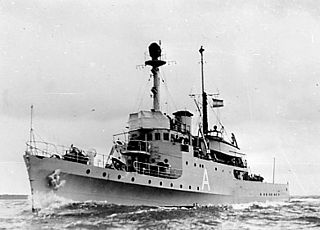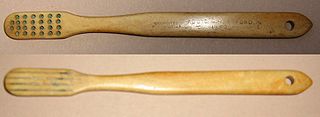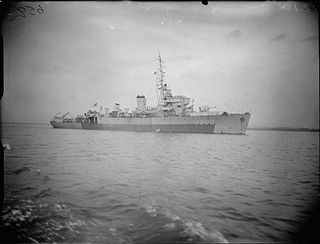Service history
Jan van Gelder was damaged by her own mines off Terschelling on 1 October 1939. At least five men were killed. After initial repairs at Willemsoord, Den Helder, she received a new stern at Gusto, Schiedam, and was recommissioned on 17 April 1940. [2]
During the invasion of the Netherlands by Germany in May 1940, she escorted the Dutch submarine O-13 to England. Later that month, on 29–31 May, she escorted the Dutch passenger ship Batavier II to Cherbourg, to pick up 280 Dutch troops.
Refitted and rearmed in 1940, she was assigned to serve with the British Royal Navy's 11th Minesweeping Flotilla, stationed in Milford Haven, Wales. Later in 1941 she served with the 9th Flotilla off Portland. She mainly acted as buoy ship, marking the swept channels. From October 1941, she swept acoustic mines off Harwich and the Isle of Wight. Later she was sent to Scotland and served as an escort ship with a British submarine flotilla. On 26 March 1943 she was transferred to the Royal Navy.
She was returned to the Netherlands in 1946 and was recommissioned in the Royal Netherlands Navy. She sailed for the Dutch East Indies where she served as patrol ship until 1950. After her return, she was rebuilt as boom defence vessel. Struck in 1961, she was then transferred to the Zeekadetkorps Nederland (Dutch Sea Cadets). She was assigned to the 'Jacob van Heemskerck' unit in the town of Schiedam, and moored at the same shipyard where she was launched 25 years earlier. The sea cadets removed the boilers for additional space, making the Jan van Gelder a stationary training ship ('floating clubhouse'). Because of severe leaking in the engine room, she was replaced in 1979, and scrapped.

HNLMS Abraham Crijnssen is a Jan van Amstel-class minesweeper of the Royal Netherlands Navy (RNN).

The Java class was a class of light cruisers of the Royal Netherlands Navy, with the lead ship named after the island of Java in the Dutch East Indies. Originally, three ships were planned: Java, Sumatra, and Celebes. Celebes was intended to be the flagship of the naval commander in the Dutch East Indies, and therefore she was slightly bigger than the other two ships. However, the contract was cancelled with 30 tons of material already prepared.

HMS Pelorus was an Algerine-class minesweeper built for the Royal Navy (RN) during World War II. Upon completion, the ship became the flotilla leader of the 7th Minesweeper Flotilla, clearing mines off the east coast of England. In June 1944, the flotilla was assigned to sweep one of the beaches during the Normandy landings until she struck a mine the following month. After her repairs were completed, Pelorus was reassigned to the English Channel and the 6th Minesweeping Flotilla. The flotilla was transferred to the Indian Ocean in 1945 and spent some time escorting convoys. They participated in Operation Collie, a bombardment of Japanese positions in the Nicobar Islands, in July and then swept the Strait of Malacca and the approaches to Singapore in August.

HNLMS Van Speijk was a K-class sloop, designed in the late 1930s to replace the aging Brinio-class gunboats of the Royal Netherlands Navy. Incomplete at the start of the German invasion of the Netherlands and not yet launched, K3 was found undamaged by the German forces. The Kriegsmarine ordered her completion, then commissioned her for service in Norwegian and German home waters.

HMS Keith was a B-class destroyer flotilla leader built for the Royal Navy around 1930. Initially assigned to the Mediterranean Fleet, she was placed in reserve in 1937, after repairs from a collision were completed. During the Spanish Civil War of 1936–1939, the ship was reactivated and spent some time in Spanish waters, enforcing the arms blockade imposed by Britain and France on both sides of the conflict. Keith escorted convoys and conducted anti-submarine patrols early in World War II before being sunk at Dunkirk by German aircraft.

The Jan van Amstel class was a class of nine minesweepers of the Royal Netherlands Navy, built to serve in the Dutch East Indies and Dutch territorial waters in Europe. The class was originally planned to consist of 12 ships, but because of the German occupation of the Netherlands in the Second World War, three of the four ships that were still under construction were never completed.

HNLMS Pieter de Bitter was a Jan van Amstel-class minesweeper of the Royal Netherlands Navy that served in World War II.

HNLMS Eland Dubois was a Jan van Amstel-class minesweeper of the Royal Netherlands Navy that served in World War II.

HNLMS Jan van Amstel was a Jan van Amstel-class minesweeper of the Royal Netherlands Navy that served in World War II.

HNLMS Willem van Ewijck was a Jan van Amstel-class minesweeper of the Royal Netherlands Navy.

HNLMS Abraham van der Hulst was a Jan van Amstel-class minesweeper built for the Royal Netherlands Navy in the 1930s. The German invasion of the Netherlands resulted in the ship being scuttled at Enkhuizen on 14 May 1940, but was raised by the Germans and entered service as the minesweeper M 553 with Nazi Germany's Kriegsmarine. The vessel was sunk by a mine off East Prussia on 21 April 1944. M 552 was raised on 20 July 1944 and towed to Stettin. There, the ship was bombed and burned out 20 August 1944. The wreck was captured by the Soviets. One source says she was returned to the Netherlands post war.

HNLMS Abraham van der Hulst was a Jan van Amstel-class minesweeper of the Royal Netherlands Navy.

HNLMS Pieter Florisz was a Jan van Amstel-class minesweeper of the Royal Netherlands Navy and Nazi Germany's Kriegsmarine during World War II.

The Douwe Aukes class were two minelayers of the Royal Netherlands Navy. The two ships were built at the Gusto shipyard in Schiedam. Construction began in 1919 and was completed in 1922. Built to serve in the Dutch territorial waters, both ships were still in service during the Second World War and they both escaped to the United Kingdom, HNLMS Douwe Aukes on 14 May and HNLMS Van Meerlant on 18 May 1940. Both vessels were transferred to the British Royal Navy. Van Meerlant was sunk by a mine in 1942 while in British service. Douwe Aukes was returned to the Royal Netherlands Navy following the war and was used as a depot ship until sold for scrap in 1962.

SS Breda was a Dutch cargo-passenger ship sunk in Scotland during World War II.
HMCS Minas was a Bangor-class minesweeper that served in the Royal Canadian Navy during the Second World War. She saw action in the Battle of the Atlantic and the Invasion of Normandy. She was named for Minas Basin. After the war she was reactivated for a short period of time in 1955 before being sold for scrap.

ZH1 was the lead ship of her class of four destroyers built for the Royal Netherlands Navy in the late 1930s. Originally named Gerard Callenburgh, the ship was scuttled while still incomplete by the Dutch during the German invasion of the Netherlands in May 1940, but she was salvaged by the Germans a few months later and commissioned in the Kriegsmarine in 1942 as ZH1.

HMCS Kenora was a Bangor-class minesweeper that served with the Royal Canadian Navy during the Second World War. Entering service in 1942, the minesweeper took part in the Battle of the Atlantic as a convoy escort and in the invasion of Normandy. Following the war, the vessel was laid up until reacquired in 1952 during the Korean War. Never re-entering service with the Royal Canadian Navy, Kenora was sold to the Turkish Navy in 1957. Renamed Bandirma by the Turkish Navy, the vessel was discarded in 1972.

HMS Cheerful (J388) was a turbine engine-powered Algerine-class minesweeper during the Second World War.

HMS Jewel (J390) was a turbine engine-powered Algerine-class minesweeper during the Second World War.
This page is based on this
Wikipedia article Text is available under the
CC BY-SA 4.0 license; additional terms may apply.
Images, videos and audio are available under their respective licenses.

















